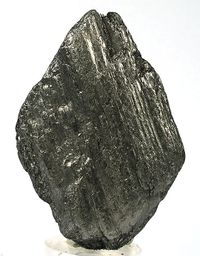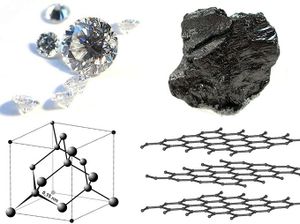Graphite: Difference between revisions
J.williams (talk | contribs) m 1 revision imported |
2dev>Rudi.Meyer No edit summary |
||
| Line 1: | Line 1: | ||
[[Category:Done | [[Category:Done 2018-12-10]] | ||
[[File:Graphite- | [[Category: Rudi grade Ashley edit]] | ||
[[File:Graphite-233436.jpg|200px|thumb|right|Figure 1. Graphite.<ref>Wikimedia Commons.(Nov.28, 2018) " Grapite" [Online], Available: https://en.wikipedia.org/wiki/Graphite#/media/File:Graphite-233436.jpg</ref>]] | |||
<onlyinclude>'''Graphite''' is a [[mineral]] composed of stacked sheets of [[carbon]] [[atom]]s with a hexagonal crystal structure.</onlyinclude> It is the most stable form of pure carbon under [[standard atmosphere|standard conditions]]. Graphite is very soft, has a low specific gravity, is relatively non-reactive, and has high [[electrical conductivity|electrical]] and [[thermal conductivity]].<ref name=mec/> | |||
Graphite is extremely soft and breaks into thin flexible flakes that easily slide over one another, resulting in a greasy feel. Due to this, graphite is a good | Graphite occurs naturally in [[Igneous rock|igneous]] and [[metamorphic rock]]s, where high temperatures and pressures compress carbon into graphite. Graphite can also be created synthetically by heating materials with high carbon content (e.g. petroleum [[coke]] or coal-tar pitch). The carbon-rich material is heated to 2500 to 3000 degrees [[Celsius]], which is hot enough to "purify" the material of contaminants, allowing the carbon to form its hexagonal sheets.<ref name= geo> King, H.M. (Nov. 28, 2018) "Graphite" [Online]. Available: https://geology.com/minerals/graphite.shtml</ref> | ||
[[File:Diamond-and-graphite2.jpg|thumb|right|Figure 2. Diamond and graphite crystal structures. Graphene would be a single layer of the graphite crystal structure.<ref>WikiMedia Commons. (Accessed Nov. 28, 2018). ''File:Diamond and graphite2.jpg'' [Online], Available: https://en.wikipedia.org/wiki/Allotropes_of_carbon#/media/File:Diamond_and_graphite2.jpg</ref>]] | |||
Graphite is extremely soft and breaks into thin flexible flakes that easily slide over one another, resulting in a greasy feel. Due to this, graphite is a good "dry" lubricant and can be used in applications where wet lubricants (like [[lubricating oil]]) cannot.<ref name=mec>Minerals Education Coalition. (Accessed September 20, 2015). ''Graphite'' [Online], Available: https://www.mineralseducationcoalition.org/minerals/graphite</ref> | |||
Carbon has several other allotropes, or forms, that occur naturally, each with their own crystal structure(Figure 2). One form is [[graphene]], which is a single layer of carbon atoms in a hexagonal pattern.<ref>Graphenea. (Accessed September 20, 2015). ''Graphene & Graphite'' [Online], Available: http://www.graphenea.com/pages/graphene-graphite#.Vf8hy_lViko</ref> Another well-known allotrope of carbon, are diamonds. Although also composed of pure carbon, diamonds are almost entirely different in their physical properties.<ref name=ref1>Minerals.net. (Accessed September 20, 2015). ''The Mineral Graphite'' [Online], Available: http://www.minerals.net/mineral/graphite.aspx</ref> | |||
==Uses== | ==Uses== | ||
Graphite is used in a number of applications that require high [[temperature]]s and need a material that will not melt or disintegrate. | Graphite is used in a number of applications that require high [[temperature]]s and need a material that will not melt or disintegrate. Graphite is used to make the crucibles for the steel industry.<ref name=mec/> Graphite is also used as a [[neutron moderator]] in certain [[nuclear reactor]]s, like the Soviet [[RBMK]], due to its ability to slow down fast-moving [[neutron]]s.<ref name =Dutta>P. Dutta. (Accessed September 20, 2015). ''What are the essential properties and uses of graphite ?'' [Online], Available: http://www.preservearticles.com/201012291918/properties-and-uses-of-graphite.html</ref> | ||
Other common uses of graphite include:<ref | Other common uses of graphite include:<ref name =Dutta/> | ||
*Pencil lead | *Pencil lead | ||
*Lubricant | *Lubricant | ||
*Electrodes | *Electrodes in batteries | ||
*Brake linings for heavy vehicles | |||
==For Further Reading== | |||
*[[Mineral]] | |||
*[[Nuclear reactor]] | |||
*[[Carbon]] | |||
*[[Atom]] | |||
*[[Neutron]] | |||
*Or explore a [[Special:Random|random page]] | |||
==References== | ==References== | ||
{{reflist}} | {{reflist}}[[Category:Uploaded]] | ||
Revision as of 23:35, 12 December 2018

Graphite is a mineral composed of stacked sheets of carbon atoms with a hexagonal crystal structure. It is the most stable form of pure carbon under standard conditions. Graphite is very soft, has a low specific gravity, is relatively non-reactive, and has high electrical and thermal conductivity.[2]
Graphite occurs naturally in igneous and metamorphic rocks, where high temperatures and pressures compress carbon into graphite. Graphite can also be created synthetically by heating materials with high carbon content (e.g. petroleum coke or coal-tar pitch). The carbon-rich material is heated to 2500 to 3000 degrees Celsius, which is hot enough to "purify" the material of contaminants, allowing the carbon to form its hexagonal sheets.[3]

Graphite is extremely soft and breaks into thin flexible flakes that easily slide over one another, resulting in a greasy feel. Due to this, graphite is a good "dry" lubricant and can be used in applications where wet lubricants (like lubricating oil) cannot.[2]
Carbon has several other allotropes, or forms, that occur naturally, each with their own crystal structure(Figure 2). One form is graphene, which is a single layer of carbon atoms in a hexagonal pattern.[5] Another well-known allotrope of carbon, are diamonds. Although also composed of pure carbon, diamonds are almost entirely different in their physical properties.[6]
Uses
Graphite is used in a number of applications that require high temperatures and need a material that will not melt or disintegrate. Graphite is used to make the crucibles for the steel industry.[2] Graphite is also used as a neutron moderator in certain nuclear reactors, like the Soviet RBMK, due to its ability to slow down fast-moving neutrons.[7]
Other common uses of graphite include:[7]
- Pencil lead
- Lubricant
- Electrodes in batteries
- Brake linings for heavy vehicles
For Further Reading
- Mineral
- Nuclear reactor
- Carbon
- Atom
- Neutron
- Or explore a random page
References
- ↑ Wikimedia Commons.(Nov.28, 2018) " Grapite" [Online], Available: https://en.wikipedia.org/wiki/Graphite#/media/File:Graphite-233436.jpg
- ↑ 2.0 2.1 2.2 Minerals Education Coalition. (Accessed September 20, 2015). Graphite [Online], Available: https://www.mineralseducationcoalition.org/minerals/graphite
- ↑ King, H.M. (Nov. 28, 2018) "Graphite" [Online]. Available: https://geology.com/minerals/graphite.shtml
- ↑ WikiMedia Commons. (Accessed Nov. 28, 2018). File:Diamond and graphite2.jpg [Online], Available: https://en.wikipedia.org/wiki/Allotropes_of_carbon#/media/File:Diamond_and_graphite2.jpg
- ↑ Graphenea. (Accessed September 20, 2015). Graphene & Graphite [Online], Available: http://www.graphenea.com/pages/graphene-graphite#.Vf8hy_lViko
- ↑ Minerals.net. (Accessed September 20, 2015). The Mineral Graphite [Online], Available: http://www.minerals.net/mineral/graphite.aspx
- ↑ 7.0 7.1 P. Dutta. (Accessed September 20, 2015). What are the essential properties and uses of graphite ? [Online], Available: http://www.preservearticles.com/201012291918/properties-and-uses-of-graphite.html

